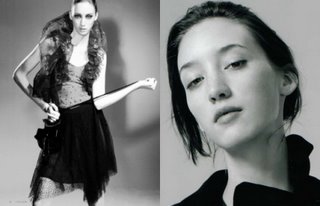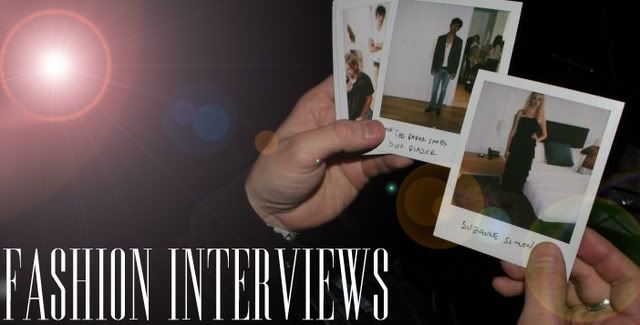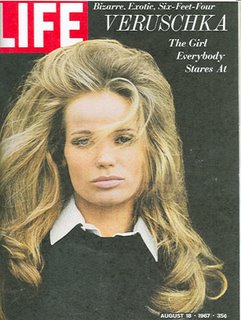Sophie Ward (2006)

O2W: How did you get involved with modeling?
Sophie Ward: The story goes like this: Gemma was in the audience to watch the competition “Search for a Supermodel” in Perth and she was discovered by an agent who saw her sitting there. She called my mum and asked her to come down to the TV studio because she was in the final 10. We (me and mum) were in the audience watching her and the judges asked me why I didn’t enter. Then I explained I was Gemma’s sister. The same agent who took on Gemma asked me to join the agency too. I couldn’t enter the competition because I had my finals three weeks later so we decided to take it slowly, at my own speed, when I had the time. A few weeks later was the “City Face Competition” (which discovered Nicole Trufino and Dion Carnell) and they asked me to enter, but I said I had to study. They begged me to come so I went in the afternoon and won the competition, That’s how I got my first photos done, in 2003, then I was at university in Perth and I kept modeling at arms length, I decided education was more important, then in the third year I was able to go to Sydney a lot for lots of different jobs, I had become more mature and learnt how to juggle lots of things.
O2W: What is it like sharing the same name as your sister who is an international supermodel?
SW: Its cool, I get to do lots of fun stuff, it’s opened the world up for the whole family. It’s made it possible for all of us to travel to see our family in England. I miss Gemma so much when she’s not here, but now I get to see her much more often. Gemma was 15 when she started, and she always had a chaperon, my mum was with her for six weeks in New York when she first went there. She was on option for Meisel the whole time and they weren’t sure how long to stay in New York for because it was costing money and nothing was happening. But she got the break and got the Prada campaign. Our parents let us try anything we like, they are really good to us. People always say that we’re so happy together and it’s true. They wanted us to experience a richer understanding of life so they were happy to see us be happy within ourselves by experiencing so much. Mum is a nurse and Dad is a doctor so they are both very educated and caring people.
O2W: Do people always compare you to her, or have expectations of you because of her?
SW: We’re both our own person, one of the main obstacles of my career is that people will always compare me to her. I didn’t want to be at IMG to begin with because it’s the same agency as Gemma but I’m glad I decided to because they understand we’re different and have different looks.
O2W: What is your relationship like with Gemma?
SW: We’re best friends. I went oversees for the first time to Glastonbury festival in England last year and we went to Porto Fino in Italy at the home of Dolce & Gabbana when Mario Testino was shooting Josh Hartnett and Gemma together. Now and again Gemma reminds me about when we were there and Mario told her that she looks so normal standing next to me because I am taller and look more couture than she does. We are very close as friends but we have strong points of difference of course. She showed me around in New York, it was amazing because she lives there most of the time and it’s like home to her now. It was her turf and it changed our relationship and took it to another level. We realized how much we love each other. We both love having our family around. It’s like your heart. We’ve spent all of our lives together but it’s hard to be apart but now I know she’s always close by no matter where I am.
O2W: What are your other brothers like?
SW: I have two brothers who are twins, Henry and Oscar. They’re 15 years old. It’s hard to tell if they’re going to model when they’re older. If it’s up to them then they won’t. It’s not something I can see them being interested in, they are really into playing basketball and they both really love school, they’re insanely smart. Oscar learnt to read when he was three, and then taught Henry how to read as well. Oscar is definitely going to be something academically extraordinary when he is older. A few years ago I told Henry that if you drink lots of milk you get strong and tall. He wants to be 6′7” tall like Michael Jordan, and I said if you drink milk it will make you grow, now he drinks two liters a day of milk, cereal three times a day.
O2W: What is it like back in Australia in the Ward family?
SW: In Perth the family house is really big and airy. It’s in the suburbs near to the river. It’s far from anywhere and so it’s expensive to travel so we would have family holidays along the coast, ride jet skis, play golf and tennis. It’s very recreational. There is no nightlife really in Perth but it’s a very safe place to live. In our house the kitchen was always the center of the house. My mum would cook lemon meringue pies because we have a lemon tree out the back. We sat for hours and hours talking when we were younger. Mum taught us how to cook and about life. People said we were like the Brady Bunch because we got on so well it was odd, we argued sure but it was always so nice to live there. We all took a course about how to resolve conflict and leave the past behind and about how live a life full of infinite possibilities. It’s called Landmark Education. You can do it all over the world. Police forces do it and now they’re trying to implement it into schools.
O2W: Where do you all live now?
SW: Gemma lives in NY most of the time. She just got her own apartment eight months ago. I’ve been living in Sydney around my friends Tiia and Dion [Carnell] for the past year and the rest of family is still in Perth. My aunty has bought a derelict French house and the whole family is going there to do it up. I think my parents want to retire to France and have goats and orchards.
O2W: What were you all like as children growing up in Perth?
It was so funny, I have so many stories. We spent our whole childhood barefoot. We had a go-cart and we could all fit on it and we would roll down the hill. We did the most crazy things in that, we jumped off the jetties and went to the ice cream stores. Holidays were spent at the beach. My favorite holidays were the ones where we banned anything with a screen (televisions, Gameboys or anything like that), so we would go camping. I remember me and Gemma had a dictaphone and we made up stories with each other and then listen back to them and laugh all night long. Before that we used to write letters to each other when we were in the car. We made up a story that I was the woman who owned a quickie mart, my brother’s character I can’t remember actually and I think Gemma was a lady who owned a tissue factory. For Gemma’s 18th birthday, I scanned all of the letters I could find and made them it into a book. She loved it so much! We also had a swing in our back garden, it was on a huge pine tree maybe 30m high and my dad put a rope on. We used to jump off the shed onto the swing and do gymnastics, then the branch fell down eventually, and we were sad.
O2W: Your Grandma has a reputation of being quite the fashionista herself. Tell me a bit about her.
SW: Oh yes, Nanna lives in Essex, just outside of London and she was the chaperon for Gemma when she came to London, so my Nanna would come. She lives alone and loves going on outings to London. She always called up the agency to ask where Gemma was staying and who she was shooting with. My bookers told me that she would ring and ask “Who is she shooting with this time, it is Nick [Knight] or Mario [Testino]” then she would say “Ok I’m going to have tea with Mario.” Gemma was so embarrassed by her for a while she came along to the shoot and tell the team which photos she likes on the computer screen. She’s so chatty and she tells you every detail of her life. I’m sure Mario was thrilled.
O2W: What have you been able to experience so far through your work?
SW: The main reason I stuck with modeling is the people, the amazingly inspiring, creative and energetic characters. There is so much life in fashion. I love that the other reason is that it opens so many doors. Gemma was really into acting and acting school doing commercials in Australia. It seemed like a good way to break into it. I think now she sees modeling as acting in a way. I think that’s why she’s such a great model. I did an arts degree and so I get to meet all of the top writers in fashion. They wouldn’t know who I was if I wasn’t a model. It’s like training for something creative.
O2W: Has it made you look at the world differently or changed your plans for the future?
I grew up next to a university so I always wanted to go there, I don’t plan too far into the future. I don’t think you can do that. Life can change so fast in a week, right now modeling has changed my life in a different direction. I’m still living a life that I love and it’s changed my life but in accordance with my heart.
O2W: What do you do like to do in your free time?
SW: I listen to music a lot, I haven’t been able to do it much recently but I love going to museums with exhibitions. I hardly go shopping, but I like going to markets, especially little antique type ones or book fair’s. I like museum shops and art gallery shops more than clothes shops. I like hanging out in the park and going to parties, dinner parties, picking cherries. I love writing emails too. I’m really dedicated to writing to my friends back at home about how I feel. I can express my emotions very easily through writing. It’s how I write when I write for magazines too, very unconscious, I never think about what I’m writing, it just comes out naturally.
O2W: How would you describe your style?
SW: I would say quite earthy, a lot of it is high fashion style but not always expensive and quite graphic too, I like lots of shapes and prints. Growing up I stood out because I’m so tall. When I was young I wanted to hide and blend it now I express it because I am tall and its part of who I am. I always try and make new combinations with all of my clothes so I have a different look each day.
O2W: Everything about you is so innocent. Surely you must have some vices?
SW: Well yes, I do, they aren’t too naughty I hope… They all begin with the letter C too….chocolate, cigarettes and coffee.





